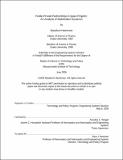| dc.contributor.advisor | Annalisa L. Weigel. | en_US |
| dc.contributor.author | Hashimoto, Masafumi | en_US |
| dc.contributor.other | Massachusetts Institute of Technology. Technology and Policy Program. | en_US |
| dc.date.accessioned | 2010-03-24T20:33:54Z | |
| dc.date.available | 2010-03-24T20:33:54Z | |
| dc.date.copyright | 2009 | en_US |
| dc.date.issued | 2009 | en_US |
| dc.identifier.uri | http://hdl.handle.net/1721.1/52751 | |
| dc.description | Thesis (S.M. in Technology and Policy)--Massachusetts Institute of Technology, Engineering Systems Division, Technology and Policy Program, 2009. | en_US |
| dc.description | This electronic version was submitted by the student author. The certified thesis is available in the Institute Archives and Special Collections. | en_US |
| dc.description | Includes bibliographical references (p. 102-107). | en_US |
| dc.description.abstract | In Public-Private Partnerships (PPPs), private partners assume more responsibility for public projects than in traditional approaches. The larger responsibility of the private partner is expected to improve efficiencies of the project. However, it also increases potential challenges such as conflicts of interest. If the dynamic structures which cause challenges in PPPs are identified, they will help to predict potential challenges in future PPP projects. Therefore, this research develops a dynamics model of which challenges arise in the application of PPP approaches to space projects. The PPP dynamics model is illustrated by using system dynamics modeling. In the first step, this research develops a traditional-approach model. In the second step, it proposes the PPP model, which is a modification of the traditional-approach model. In the third step, this research tests the PPP model by applying it to four space-related PPP cases: the European navigation system Galileo, the Japanese navigation system QZSS, the Japanese launch vehicle GX, and the U.S. launch vehicle families EELV. The PPP model passes these four tests. In the PPP model, three variables play important roles: conflicts of interest among parties, user satisfaction, and the private partner's revenue risk. The three variables represent interests of stakeholders such as the public sector, private partners, and users. Conflicts of interest among parties increase cost schedule inefficiencies. More cost schedule inefficiencies lead to less user satisfaction. Less user satisfaction results in more revenue risk for the private partner. More revenue risk for the private partner leads to more conflicts of interest among parties. | en_US |
| dc.description.abstract | (cont.) Thus, the interaction of stakeholder interests forms a reinforcing loop unique to PPPs. Additionally, unexpected technical and demand problems strengthen the reinforcement. This reinforcing loop and these unexpected problems are the inherent sources of challenges in space-related PPP projects. Lessons for improving the dynamic structures of space-related PPPs are (1) to set cost saving as the primary goal, (2) to choose the government customer market, and (3) to adopt conservative technical and demand forecasts. Based on these lessons, this research proposes that potential missions suitable for future space-related PPPs might be telecommunication, Earth observation, and meteorological monitoring for governments' use. | en_US |
| dc.description.statementofresponsibility | by Masafumi Hashimoto. | en_US |
| dc.format.extent | 107 p. | en_US |
| dc.language.iso | eng | en_US |
| dc.publisher | Massachusetts Institute of Technology | en_US |
| dc.rights | M.I.T. theses are protected by
copyright. They may be viewed from this source for any purpose, but
reproduction or distribution in any format is prohibited without written
permission. See provided URL for inquiries about permission. | en_US |
| dc.rights.uri | http://dspace.mit.edu/handle/1721.1/7582 | en_US |
| dc.subject | Engineering Systems Division. | en_US |
| dc.subject | Technology and Policy Program. | en_US |
| dc.title | Public-private partnerships in space projects : an analysis of stakeholder dynamics | en_US |
| dc.type | Thesis | en_US |
| dc.description.degree | S.M.in Technology and Policy | en_US |
| dc.contributor.department | Massachusetts Institute of Technology. Engineering Systems Division | |
| dc.contributor.department | Technology and Policy Program | |
| dc.identifier.oclc | 501191812 | en_US |
